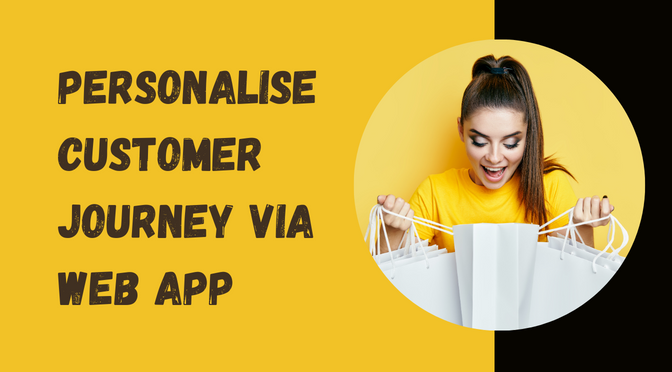In the current digital landscape, the retail industry has undergone several transformative changes. Offering supreme customer services is not restricted to having a unique pricing strategy and offering promotions, as in the case of the traditional differentiation approach. No effort is worth it if businesses fail to understand the customer journey and then make decisions based on that understanding.
Personalisation is an element that can help retail businesses distinguish themselves from their competitors and create a unique value for their business. When done right, the personalisation factor can be overlooked by customers, but any mistake from retailers will lead them to switch to competitors. When customers feel that their queries and needs are addressed, it likely increases the chance of getting a loyal customer.
What possibilities can you think of that can help retailers improve their customer journey and offer them exceptional services?
One way retailers are turning to is having a robust web application to deliver customised experiences. Web applications that leverage data analytics, AI, and machine learning can gather insights regarding customer behaviour, fostering the decision-making process and enabling retailers to offer personalised product recommendations.
Let’s witness how retailers can personalise their customer journey with web application solutions:
1. Optimise retaining efforts before customers switch to competitors
Have you ever noticed how pesky popup messages force you to buy that favourite item in your cart for a long time, especially when you are in a dilemma about whether to buy that or not? That’s the power of personalisation!
I am wondering how that happens. Personalization is based on activities carried out by users on websites, such as session time on the web page, browsing patterns, and type of cart content, which are just among the few. This feature helps businesses acquire customers and retain the existing ones by facilitating personalised pop-ups.
2. Relish the benefits of integrating web applications with CRM systems

Integrating web applications with CRM systems, such as Salesforce, can help businesses track customer integrations and boost their personalisation game by getting a comprehended and centralised view of the metrics.
With such data, retailers can check whether their marketing efforts are aligning well with the customer’s expectations and accordingly tailor marketing campaigns that resonate with the customer’s preferences.
3. Tailoring experience with customised content
Many ecommerce giants adopt this strategy to boost their sales by tailoring website content as per customer preferences. It involves displaying content involving various factors such as location, user behaviour, and interacting patterns. For instance, you must have received recommendations per your location, including local events, weather-related information, and specific location-based services.
This would help retailers to offer location-based services through web applications. Additionally, by analysing user behavior through their browsing history, web apps can tailor content, such as if users read more regarding fitness, then apps can show more fitness products.
4. Omnichannel integration for elevating customer experience
Omnichannel communication facilitates boosting the communication between customers and your business. It facilitates customers’ switching between channels without losing context; they can start a buying journey on one channel and complete it on another.
Today, businesses are present on multiple social platforms, and it’s their responsibility to ensure that the message, branding, and overall customer experience remain constant across all channels. This aids in building brand loyalty and maintaining trust among users. Web applications ensure the creation of a seamless experience across various channels, such as website, mobile, or in-store.
5. Adopting chatbots for resolving queries promptly

Have you ever felt frustrated by calling customer support again and again just to express your experience or resolve any issue? In the current business scenarios, solving customers’ queries promptly is the key to ensuring their concerns are heard.
It creates a sense of brand loyalty for them. Chatbots provide round-the-cloud support by solving queries and ensuring 24/7 availability, thus drastically reducing the wait times by boosting prompt replies. Moreover, chatbots can handle various queries, from basic to complex ones.
6. Offer after-sales support
Retailers’ roles are not limited to selling products or generating wholesome experiences during the sales period. Instead, they include offering quality services after sales. Offering tailored after-sales support via a website is an essential parameter that businesses ignore.
Businesses can analyse user data to personalise communication by addressing users by name, adding relevant information based on their purchase history, or even sending product recommendations for further buying. Additionally, it can include a post-purchase survey, exclusive offers, and thank-you notes. All these tactics can add a personalised touch and contribute to a better customer experience.
7. Integrating interactive features to boost engagement
To significantly enhance the shopping experience, intuitive interactive features stand out as they add fun elements. For instance, adding quizzes can be a great way to help customers discover products and learn more about their features in a quirky way.
In today’s digital landscape, virtual try-on tools allow customers to see how a product would look on them, get the exact match according to their preference, and make a confident purchase decision. This is all thanks to augmented reality and virtual reality technology.
Final words
As technology evolves, retailers must innovate their tactics to interact better with customers to offer unique shopping experiences. To personalise the user experience and offer suggestions based on their interest, businesses can integrate various channels such as social media, email, and in-app messaging with web applications to gather more data regarding customer behaviour.
Apart from offering a personalised user experience, having a robust web application can automate several operational processes such as inventory management, order fulfillment, and transportation tracking. By digitising these operations, retailers can significantly improve efficiency and minimise the cost by eliminating surveillance and manual costs.
Offering personalisation by leveraging web app-based solutions boosts conversion and retention by creating wholesome web experiences. Being there with customers at each stage of their buying journey is vital for retailers seeking to stay competitive by driving engagement, loyalty, and sales.
Author:
Gaurav Goyal: As the Chief Technical Officer and Co-Founder at Canopus Infosystems Pvt Ltd, I bring over two decades of experience. My journey began with a graduation in Computer Programming in 2003. Since then, I’ve honed my skills in managing data science teams, quantitative research, and algorithmic trading. My track record boasts expertise in robust statistics, machine learning, and large data analytics, all of which have contributed to successfully delivering 500+ projects to 200+ clients.



